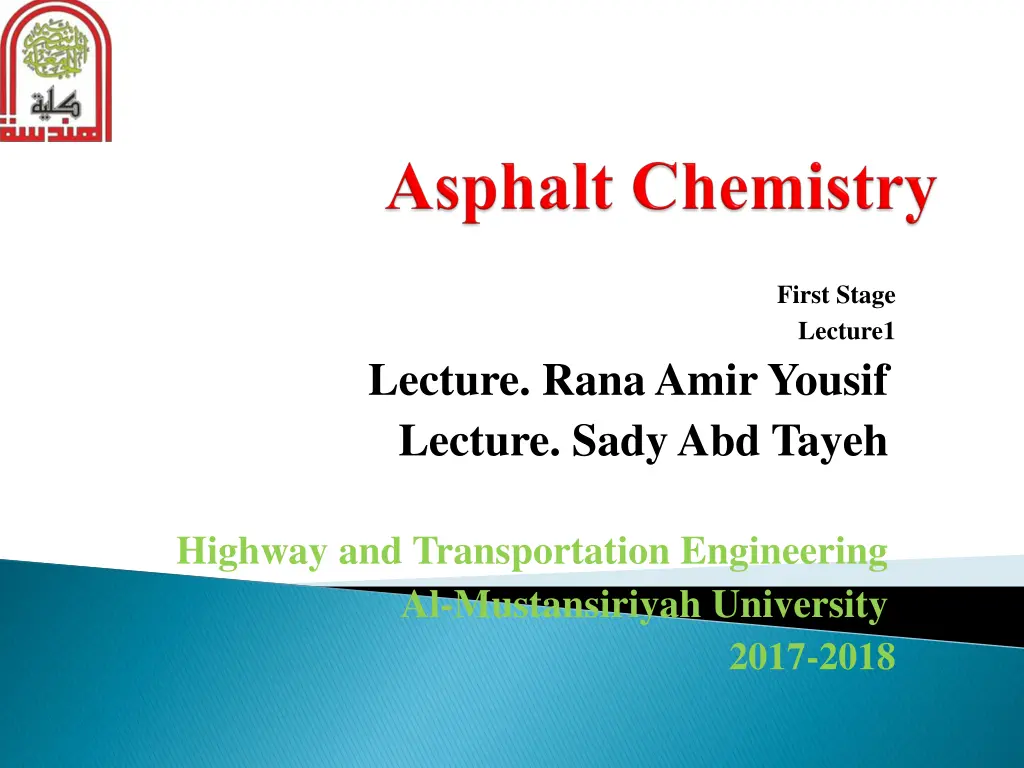
Bitumen and Asphalt: Definitions, Properties, and Applications
Discover the definitions and properties of bitumen and asphalt, essential substances in highway and transportation engineering. Learn about their origins, classifications, and uses in construction. Explore the distinctions between bitumen and asphalt, as well as their roles in creating durable pavements. Gain insights into the scientific and practical aspects of these materials, from their natural occurrences to modern applications in infrastructure projects.
Download Presentation

Please find below an Image/Link to download the presentation.
The content on the website is provided AS IS for your information and personal use only. It may not be sold, licensed, or shared on other websites without obtaining consent from the author. If you encounter any issues during the download, it is possible that the publisher has removed the file from their server.
You are allowed to download the files provided on this website for personal or commercial use, subject to the condition that they are used lawfully. All files are the property of their respective owners.
The content on the website is provided AS IS for your information and personal use only. It may not be sold, licensed, or shared on other websites without obtaining consent from the author.
E N D
Presentation Transcript
First Stage Lecture1 Lecture. Rana Amir Yousif Lecture. SadyAbd Tayeh Highway and Transportation Engineering Al-Mustansiriyah University 2017-2018
References: Edwin J. Barth. Asphalt Science and Technology , 1st Ed. ,1962. James Speight Asphalt Materials Science and Technology , 1st Edition 2015.
Definitions The Dictionary Definition Asphalt: A bituminous substance, found in many parts of the world, a smooth, hard, brittle, black or brownish-black resinous mineral, consisting of a mixture of different hydrocarbons; called also mineral pitch, Jew s pitch and in the Old Testament slime . Definitions Oxford English Dictionary Oxford English Dictionary Bitumen: Originally, a kind of mineral pitch found in Palestine and Babylon, used as mortar, etc. The same as asphalt, mineral pitch, Jew s pitch, Bitumen Judaicum. In modern scientific use, the generic name of certain inflammable substances, native hydrocarbons more or less oxygenated, liquid, semi-solid and solid, including naphtha, petroleum, asphalt, etc. Elastic Bitumen: Mineral Caoutchouc or Elaterite. Oxford English Dictionary Oxford English Dictionary
Bituminous materials: a class of black or dark-colored (solid, semi-solid or viscous) cementitious substances, natural or manufactured, composed principally of high molecular weight hydrocarbons, of which asphalts, tars, pitches, and asphaltites are typical. ASTM D8-97-2000 Asphalt: A natural or artificial mixture of bitumen with mineral matter Bitumen: The heaviest fraction of petroleum; it can be petroleum bitumen or natural bitumen RILEM Technical Committees, 1992 (Organic Binders) Asphalt: is a substance that causes particles of sand, gravel and crushed stone to stick together to form a pavement. Highway Engineer
(Straight run) Asphalt (with the exception of natural asphalt) is a residue of petroleum or a product of solvent extraction of petroleum. It is a complex mixture of thousands of different organic compounds mutually dissolved or dispersed. Petroleum Chemist And Finally the Correct Statement about Bitumen The word bitumen may, therefore, be strictly defined as a generic term that is used to designate a class of minerals as they occur in nature . .. They all consist principally of compounds of carbon and hydrogen, but often contain compounds of nitrogen, sulphur and oxygen, and in the solid forms, compounds of iron and alumina. Peckham (1895), Chemist, Department of Finance, City of New York.
In Europe, asphalt means a mixture of aggregates and bitumen. (Lake Asphalt in Trinidad!!!) In North America, asphalt means bitumen. Hard (Low penetration) Soft (High penetration)
Asphalt is a complex mixture of many different hydrocarbons. The asphalt constituents are classified into three categories: Oils; Resins; and Asphaltenes. 1. Oils are the light compounds in asphalt which have the lowest molecular weights (24-800) and have a large number of side chains and few rings. Accepted criteria for the oil classification are molecules with carbon/hydrogen atom number ratios less than 0.6 that are soluble in hexane. 2. Resins are intermediate molecular weights compounds (800-2000). It is important to note that resins can contain sulfur and nitrogen. Resins are polar, have a carbon/hydrogen ratio between 0.6-0.8 and are soluble in light petroleum naphtha. 3. Asphaltenes are the highest molecular weights compounds (1800-8000) with aromatic ring structures, few side chains and carbon/hydrogen ratio greater than 0.8. Asphaltenes contain the trace elements which may react with potential polymers and are soluble in carbon-tetrachloride. An average asphalt sample has an sphaltenes/resin/oil weight ratio of approximately 23/27/50 as example and asphaltene content is higher for harder asphalts. The engineering properties of asphalt binders are directly related to the quantity and the quality of asphaltenes percent and the nature of the dispersion medium, oils and resins.






















